 National award-winning illustrator: illustrations for the book "A
Garden of Wildflowers" won the Garden Writers of America 1st Place award
for book illustration. The artwork samples in this portfolio range from rich and vibrant colored pencil drawings for trade books, pen and ink drawings,
watercolors, and Photoshop illustrations created for print and the web.
National award-winning illustrator: illustrations for the book "A
Garden of Wildflowers" won the Garden Writers of America 1st Place award
for book illustration. The artwork samples in this portfolio range from rich and vibrant colored pencil drawings for trade books, pen and ink drawings,
watercolors, and Photoshop illustrations created for print and the web.
Roberts Rinehart Publishers
Niwot, Colorado
This was a 28 page trade children's nature book, published in hardback.
It has now gone through several paperback reprints and has sold almost 50,000 copies.
The illustrations were created using Berol Prisma Color colored pencils.
The colored pencil technique I use is to xerox my original pencil drawings onto velum bristol board stock
(which creates smudge-proof black outlines and some shading), and then color them in with colored pencils,
in multiple overlapping layers of color. The black lines and shading show through the overlaying color.
There can be more than 10 layers of color in each area of the drawing. The final layers are
given pressure to blend and smooth the colors giving the finished piece the vibrant appearance
of an oil painting.
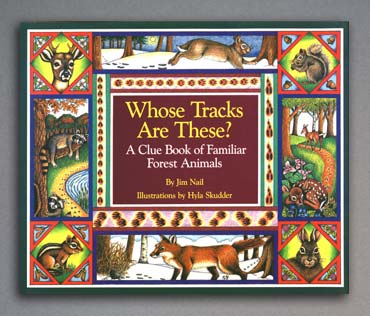 Cover of book dust jacket. I did both the book design and the book illustrations. Illustrations -- colored pencil.
Cover of book dust jacket. I did both the book design and the book illustrations. Illustrations -- colored pencil.
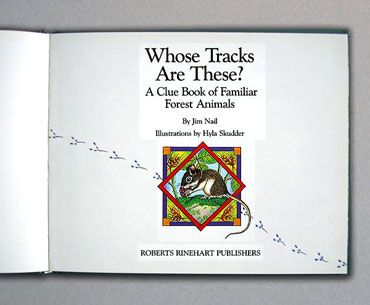 Title page of the book. This was one of the species that could not be covered in the book due to page limitations,
so I worked the white-footed mouse in here with it's tracks.
Title page of the book. This was one of the species that could not be covered in the book due to page limitations,
so I worked the white-footed mouse in here with it's tracks.
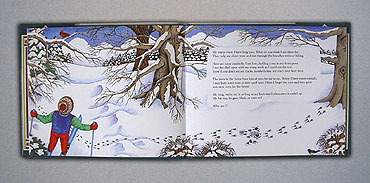 This is the first clue page of the book. There are written clues, but also visual clues
(such as chewed nut shells) in the illustration. One of my sons patiently posed in full cross-country ski gear while
I sketched him from above in my loft.
This is the first clue page of the book. There are written clues, but also visual clues
(such as chewed nut shells) in the illustration. One of my sons patiently posed in full cross-country ski gear while
I sketched him from above in my loft.
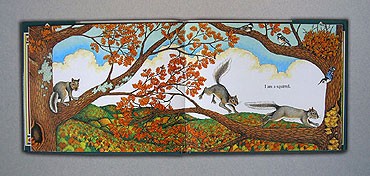 This is the first "reveal" page of the book, where you see who the animal is. I tried to show a variety
of seasons throughout the book. The low rolling Catskill Mountains of New York state, where I grew up, crept into
the background on their own.
This is the first "reveal" page of the book, where you see who the animal is. I tried to show a variety
of seasons throughout the book. The low rolling Catskill Mountains of New York state, where I grew up, crept into
the background on their own.
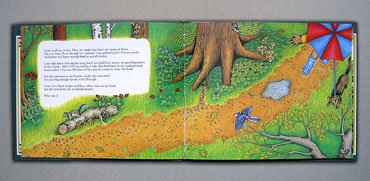 This is the second "clue" spread of the book. The illustrations on the clue page follow the book's premise
that most of the time children will discover animal tracks "by accident" while they are engaged in everyday activities.
This is the second "clue" spread of the book. The illustrations on the clue page follow the book's premise
that most of the time children will discover animal tracks "by accident" while they are engaged in everyday activities.
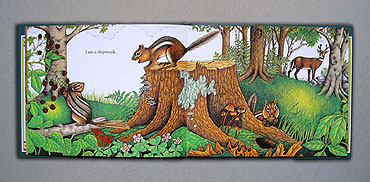 This is the second "reveal" spread of the book. I drew these chipmunks (my favorite forest animal) from photos of several
charming characters who regularly visit my back yard. The deer in the background is actually the next animal to be covered.
Smart readers will figure out this pattern.
This is the second "reveal" spread of the book. I drew these chipmunks (my favorite forest animal) from photos of several
charming characters who regularly visit my back yard. The deer in the background is actually the next animal to be covered.
Smart readers will figure out this pattern.
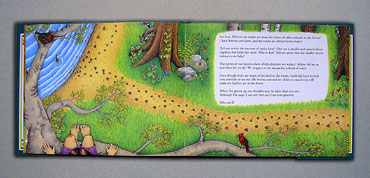 Yes, that's a bit of an autobiographical portrait of my younger self up in the tree (where I could frequently be found), complete with bandaid on the knee.
Yes, that's a bit of an autobiographical portrait of my younger self up in the tree (where I could frequently be found), complete with bandaid on the knee.
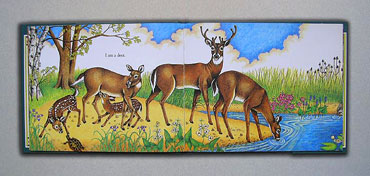 In the previous spread, the tracks of two deer, an adult and a young one, come to the water to drink. This is not
explained in the text -- the reader has to try to figure this out on their own. So in this following spread I show the
herd of deer doing that activity.
In the previous spread, the tracks of two deer, an adult and a young one, come to the water to drink. This is not
explained in the text -- the reader has to try to figure this out on their own. So in this following spread I show the
herd of deer doing that activity.
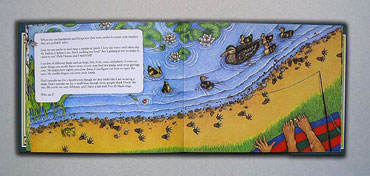 This is the "clue" page for the raccoon. Their tracks resemble small human hands, so I have the hand of the child
sitting on the beach towel showing for comparison.
This is the "clue" page for the raccoon. Their tracks resemble small human hands, so I have the hand of the child
sitting on the beach towel showing for comparison.
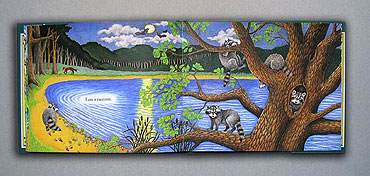 This spread for the raccoon family depicts the night time, since they are nocturnal animals (I worked in a few bats too).
This spread for the raccoon family depicts the night time, since they are nocturnal animals (I worked in a few bats too).
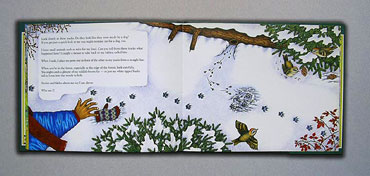 I love reading the "stories" of animals' and birds' activities in the snow in winter. This is a scene I came across
in real life. Can you tell what's happened???
I love reading the "stories" of animals' and birds' activities in the snow in winter. This is a scene I came across
in real life. Can you tell what's happened???
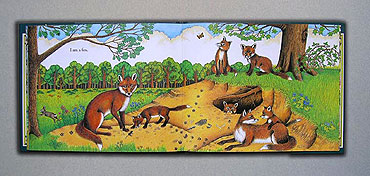 This is shown in a different season, but here you see the results of the story from the previous spread (in case it's too
small to see here, that's a dead mouse the cub is sniffing at).
This is shown in a different season, but here you see the results of the story from the previous spread (in case it's too
small to see here, that's a dead mouse the cub is sniffing at).
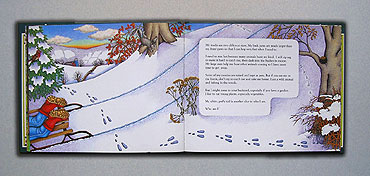 Many of my landscapes are drawn from my memories. Even though I have lived in Ohio for almost 20 years now, this scene
from the Catskill Mountains of my childhood in New York state just wanted to come out.
Many of my landscapes are drawn from my memories. Even though I have lived in Ohio for almost 20 years now, this scene
from the Catskill Mountains of my childhood in New York state just wanted to come out.
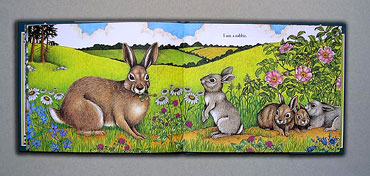 Wildflowers are one of my special loves, so I was able to work several of them into this summer meadow scene. And this
was finally an Ohio scene.
Wildflowers are one of my special loves, so I was able to work several of them into this summer meadow scene. And this
was finally an Ohio scene.
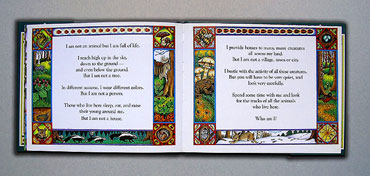 This spread of the book was a longer riddle with clues about the environment itself. In these borders I worked in many other
details of creatures, insects and plants.
This spread of the book was a longer riddle with clues about the environment itself. In these borders I worked in many other
details of creatures, insects and plants.
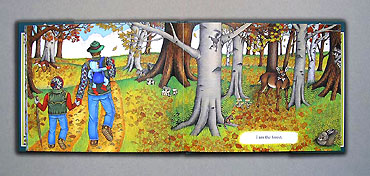 This final spread of the book featured drawings of my family, in addition to all the animals who had been in the book. Even though
humans appear throughout the book, the publisher did not want to show any faces so as not to distract attention from the
main focus of the book, which was the animals and their tracks.
This final spread of the book featured drawings of my family, in addition to all the animals who had been in the book. Even though
humans appear throughout the book, the publisher did not want to show any faces so as not to distract attention from the
main focus of the book, which was the animals and their tracks.
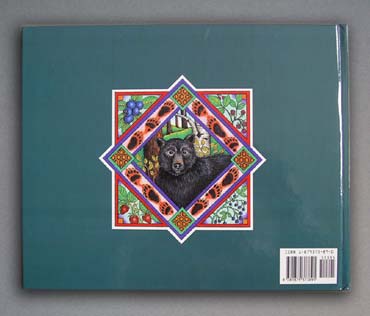 The black bear is another one of my favorite Northeast forest animals, and there were not enough pages to include it. So I added
the bear to the back cover of the book, in a border featuring its tracks and common foods.
The black bear is another one of my favorite Northeast forest animals, and there were not enough pages to include it. So I added
the bear to the back cover of the book, in a border featuring its tracks and common foods.
